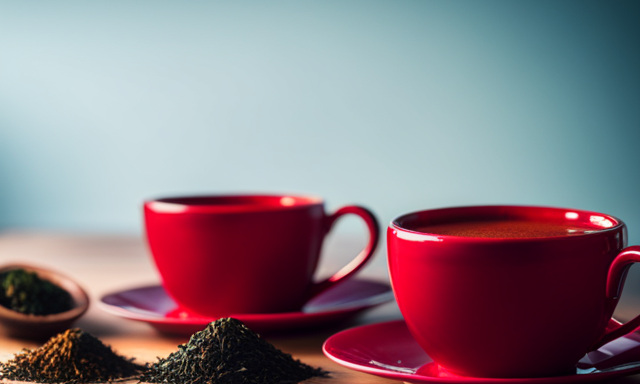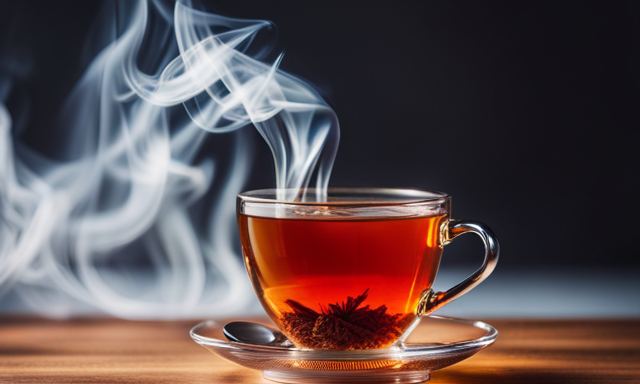Like a warm hug on a chilly day, rooibos tea has always been a comforting presence in my life. Its rich, earthy flavor and soothing properties have made it my go-to beverage for relaxation and rejuvenation. But have you ever wondered where this delightful tea originates from?
Join me on a journey to discover the origins of rooibos tea, as we delve into the fascinating history and unique cultivation process of this South African gem.
From the vast rooibos plantations in the Western Cape province of South Africa, where the tea leaves are carefully harvested and processed, to the health benefits and various flavors it offers, we will explore it all.
I will also share tips on how to brew the perfect cup of rooibos tea and guide you on where to find authentic rooibos tea products.
So, grab a cup of this delightful brew, sit back, and let’s embark on an adventure to unravel the secrets of rooibos tea.
Key Takeaways
- Rooibos tea has deep cultural roots in South Africa and is consumed by the indigenous Khoisan people.
- Rooibos tea has a significant economic impact in South Africa, creating job opportunities and contributing to the export industry.
- Rooibos plants require specific environmental conditions to thrive, such as well-drained sandy soils and a Mediterranean climate.
- Authentic rooibos tea products can be found at specialty tea shops or online retailers, sourced directly from South Africa.
The History of Rooibos Tea in South Africa
The history of rooibos tea in South Africa can’t be ignored, as it has deep cultural roots in the country. Rooibos tea has been consumed by the indigenous Khoisan people for centuries, and it holds a special place in their traditions and rituals.
The cultural significance of rooibos tea is evident in its use during important ceremonies and gatherings, where it’s believed to bring people together and promote unity.
In addition to its cultural importance, rooibos tea also has a significant economic impact in South Africa. The production of rooibos tea has created job opportunities for many local farmers and has contributed to the country’s export industry.
With such a rich history and economic importance, it’s no wonder that the unique cultivation process of rooibos tea is equally fascinating.
The Unique Cultivation Process of Rooibos Tea
When you brew rooibos, did you know that it takes approximately nine months for the plant to reach maturity? The unique cultivation techniques used for rooibos tea contribute to its distinct flavor and health benefits.
Rooibos plants require specific environmental conditions to thrive, such as well-drained sandy soils and a Mediterranean climate. Farmers carefully monitor the growth of the plants, ensuring they receive adequate sunlight and water throughout the year.
The cultivation process also involves regular pruning to promote bushy growth and encourage the development of high-quality leaves. These techniques not only enhance the taste and aroma of rooibos tea but also minimize its environmental impact by conserving water and reducing the need for pesticides.
Exploring the rooibos tea plantations in South Africa allows visitors to witness firsthand the meticulous care and dedication put into cultivating this remarkable herbal tea.
Exploring the Rooibos Tea Plantations in South Africa
Exploring the beautiful Rooibos tea plantations in South Africa allows visitors to experience firsthand the meticulous care and dedication put into cultivating this remarkable herbal beverage.
These plantations not only offer breathtaking views of the vibrant red rooibos fields, but also showcase the sustainable practices implemented by local farmers. From organic farming methods to water conservation techniques, the commitment to environmental stewardship is evident.
Moreover, the economic impact of the Rooibos tea industry on local communities cannot be overstated. The plantations provide employment opportunities and contribute to the growth of the region’s economy.
As I walked through the plantations, I couldn’t help but appreciate the harmonious blend of nature and human ingenuity.
Transitioning into the subsequent section about harvesting and processing rooibos leaves, it is fascinating to witness how the carefully nurtured plants are transformed into the flavorful tea we all enjoy.
Harvesting and Processing Rooibos Leaves
Walking through the plantations, you can’t help but be captivated by the fascinating process of how the carefully nurtured plants are transformed into the flavorful tea we all love. Harvesting techniques play a crucial role in the rooibos tea production.
The leaves are hand-picked by skilled workers, ensuring that only the highest quality leaves are selected. These leaves are then taken to the processing facility, where they undergo a meticulous process. First, the leaves are bruised and left to ferment, which gives them their distinctive red color and enhances their flavor.
After fermentation, the leaves are spread out to dry in the sun. This step helps to lock in the unique taste and aroma of rooibos tea. Finally, the dried leaves are sorted, packaged, and ready to be enjoyed.
Transitioning into the subsequent section about the health benefits of rooibos tea, it’s important to understand the care and expertise that goes into its production.
The Health Benefits of Rooibos Tea
Indulging in a cup of this amber elixir can bring a wave of well-being, like a soothing balm for both body and soul.
Rooibos tea is not only delicious but also offers numerous health benefits. One of the key advantages of rooibos tea is its antioxidant properties. It contains antioxidants like aspalathin and quercetin, which help protect the body against free radicals and oxidative stress. These antioxidants may also have potential anti-inflammatory effects, reducing inflammation in the body and promoting overall well-being.
Moreover, studies have suggested that rooibos tea may have a positive impact on heart health, blood sugar levels, and skin conditions. With its many health benefits, it’s no wonder that rooibos tea has gained popularity worldwide.
Now, let’s explore the different varieties and flavors of rooibos tea.
Different Varieties and Flavors of Rooibos Tea
With its wide range of flavors and unique varieties, sipping on a cup of rooibos tea is like embarking on a tantalizing journey for your taste buds. Whether you prefer a classic rooibos flavor or want to try something more adventurous, there are different rooibos tea brands that offer a variety of options to suit your preferences.
From fruity and floral blends to spicy and herbal infusions, you can explore a world of tastes with rooibos tea. In addition to enjoying it plain, you can also experiment with rooibos tea recipes, such as adding it to smoothies or using it as a base for iced tea.
Now that you know about the different varieties and flavors of rooibos tea, let’s delve into the art of brewing the perfect cup.
How to Brew the Perfect Cup of Rooibos Tea
To achieve the ideal infusion of flavors, you’ll need to steep your rooibos leaves in freshly boiled water for a recommended time of five minutes. Brewing techniques can vary depending on personal preference, but this method ensures a well-balanced cup of rooibos tea.
To enhance your tea-drinking experience, try experimenting with different rooibos tea recipes. You can add a splash of milk and a drizzle of honey for a creamy and sweet taste, or infuse it with citrus fruits for a refreshing twist. The possibilities are endless!
For a quick reference on brewing times and temperatures, refer to the table below:
| Tea Type | Water Temperature (°C) | Steeping Time (minutes) |
|---|---|---|
| Green Rooibos | 85-90°C | 3-4 |
| Red Rooibos | 100°C | 5 |
| Honeybush | 95-100°C | 5-6 |
| Herbal Rooibos | 100°C | 5-7 |
Now that you know how to brew the perfect cup, let’s explore where to buy authentic rooibos tea products.
Where to Buy Authentic Rooibos Tea Products
Now that you know how to brew the perfect cup of Rooibos tea, let’s explore where you can buy authentic Rooibos tea products.
As an avid tea lover, I’ve found that the best place to find organic Rooibos tea is at specialty tea shops or online retailers that specialize in tea. These sources often have a wide selection of high-quality Rooibos teas that are sourced directly from South Africa, where Rooibos tea originated.
When purchasing Rooibos tea, it’s important to look for organic options to ensure that you’re getting the purest and most natural product. Additionally, these retailers often provide helpful information and recipes on how to incorporate Rooibos tea into your daily routine.
So, whether you’re looking for loose leaf Rooibos tea or convenient tea bags, these sources will have you covered.
Frequently Asked Questions
Is rooibos tea only grown in South Africa?
Rooibos tea is primarily cultivated in South Africa, making it synonymous with the region. However, due to its global popularity, it is now grown in other countries like China, Japan, and even the United States.
How long does it take for a rooibos tea plant to fully mature?
It typically takes a few years for a rooibos tea plant to reach full maturity. Factors like soil quality, climate, and cultivation practices can affect the growth rate and overall development of the plant.
What are the traditional uses of rooibos tea in South African culture?
Rooibos tea has traditional medicinal uses and cultural significance in South African culture. It is believed to have various health benefits and is commonly used to alleviate allergies, promote digestion, and boost the immune system.
Are there any environmental concerns associated with the cultivation of rooibos tea?
There’s an old saying, "We do not inherit the earth from our ancestors, we borrow it from our children." When it comes to rooibos tea, its cultivation has an environmentally friendly impact due to sustainable farming practices.
Can I grow my own rooibos tea plant at home?
Sure, you can grow your own rooibos tea plant at home. It requires warm temperatures, well-drained soil, and plenty of sunlight. Harvesting is done by hand, where the leaves are carefully plucked and then dried.
Conclusion
In conclusion, discovering the origins of rooibos tea has been an enlightening journey. I explored the lush plantations nestled in the heart of South Africa. The sight of vibrant red leaves dancing in the breeze was a feast for the senses. Witnessing the meticulous harvesting and processing of these leaves, I couldn’t help but marvel at the dedication and skill involved.
And now, armed with knowledge of its health benefits and diverse flavors, I eagerly await the moment when I can brew a cup of this exquisite tea and savor its rich, earthy goodness. If you’re looking to experience the true essence of rooibos tea, look no further than the authentic products available for purchase.










